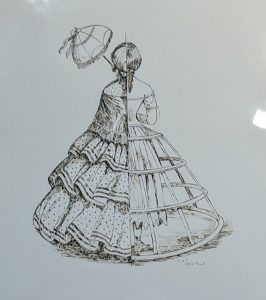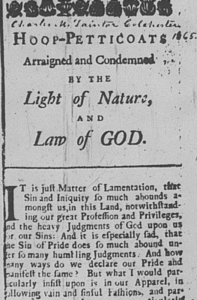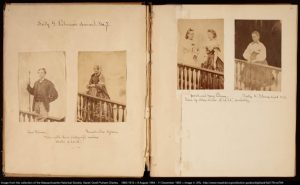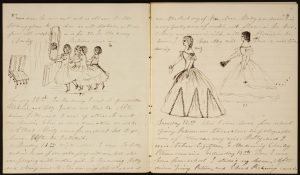by Angela Tillapaugh, Library Assistant


However religious leaders of the church condemned the garments because the lightness of the hoop skirts often caused them to raise and expose undergarments or bare skin. Newspapers also published satirical cartoons and articles exaggerating how impractical wide skirts were, suggesting women got stuck in doorways or crushed men with their hoops. Despite the controversy, women continued to wear hooped undergarments until the silhouette fell out of fashion around the 1780s.
Full skirts became fashionable again only a few decades later in the United States. At first women used other means to achieve the desired full skirt by wearing crinolines, which were petticoats stiffened with baleen and horsehair. The heaviness of these crinoline made hoop skirts appealing once again. The trend of hooped petticoats really took hold after the invention of spring steel petticoats (also called crinolines) around 1850. These new undergarments eliminated the need for layers of stiffened garments, allowed the legs to move easily, and sit comfortably.[i] This type of undergarment is likely what is depicted on the young women in the image above.


While the image of dresses with large hooped skirts are often associated with the antebellum period of the South the new spring steel hoop skirt became enormously popular, often dubbed “crinolinemania”. There were over 100 factories in New England making hooped petticoats and were even worn by women in rural areas of western Massachusetts.[ii] Sara Gooll Putnam of Boston often included photos and drawings of her friends and family wearing full skirted dresses in her diary entries.
The hoop skirt remained popular for many decades but eventually the style fell out of favor by the end of the 1860s. The condemnation of hooped skirts became stronger after the end of the Civil War, particularly by ministers.[iii] Additionally, the garments were impractical. While spring steel crinolines were an improvement wide skirts were still cumbersome, and in some cases even dangerous. In 1858 the New York Times reported that a woman in Boston died after standing too close to a fire in a crinoline, and that 19 women in England died due to crinoline related deaths.[iv] While the hoop skirt gave women a taste of freedom and mobility, eventually they wanted to have even more freedom of movement that a wide skirt cannot provide regardless of the undergarments holding it up.
[i] Erin Blakemore, “Why Hoop Petticoats Were Scandalous,” JSTOR Daily (JSTOR, January 28, 2018), https://daily.jstor.org/why-hoop-petticoats-were-scandalous/)
[ii] Lazaro, David E. “Supporting Role: The Hoop Skirt in 1860s Western Massachusetts Fashion.” In Dressing New England : Clothing, Fashion and Identity, 31. Deerfield, MA: Dublin Seminar for New England Folklife, 2010.
[iii]Abbott, Karen. “Death by Crinoline.” Wonders & Marvels. Accessed January 10, 2020. http://www.wondersandmarvels.com/2012/08/death-by-crinoline.html.
[iv] “The Perils of Crinoline.” The New York Times, March 16, 1858.


Very well written and interesting article, Angela.
Very well done:)